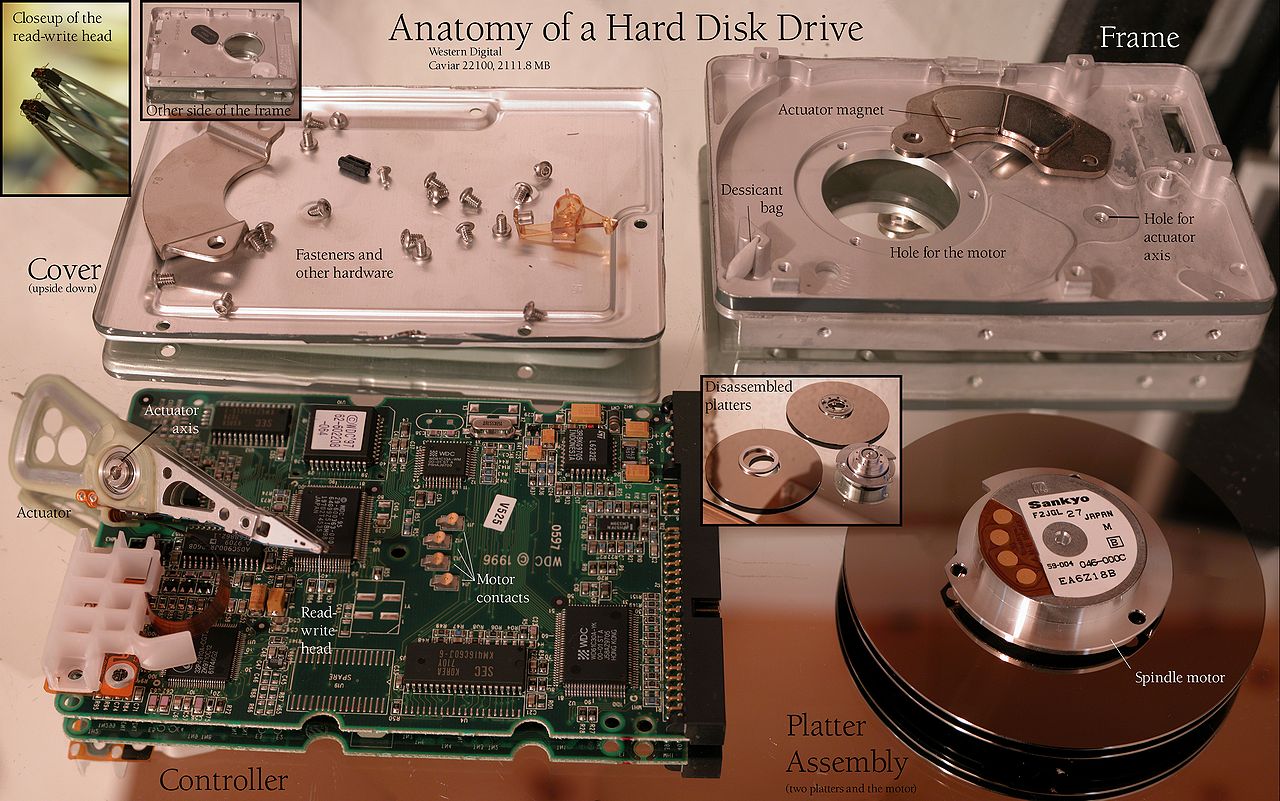
Take a peek into the Hard Drive. Curious how does the Hard Drive works?
Have you ever wondered how does your hard drive looks like on the inside? While it is never a good idea to open up a perfectly good working hard drive, if you happen to have one which you plan on throwing away, go ahead and open it up. That way I can walk you through every single component that you’ll find inside. After this, you’ll have a better understanding of what your hard drive works, what it does and when it does its job. This post will also provide you with insights on various failures that can take place within a hard drive.
First off, I want to point out that although there are many different types of hard drives available in the market, most of the modern ones consist of similar components. There are some with slight variations depending on the brand and model respectively.
Let's start!
All drives work in similar ways when you strip them down to technical specs. The components are all made to essentially work in the same manner.
First, let’s look at the Seagate drives and the components they share.
Both Seagates (3.5 and 2.5) are made in a similar manner except the 3.5 drive has the top protector which is sometimes called a Top Dumper. These protectors are known to reduce noise and are usually made of aluminum or plastic. Below is an example of a Top Dumper on a Seagate 3.5” 3TB ST3000DM001. The top dumper is usually seen on a newer type hard drives rather than old.
Both drives share the necessary components such as:
- Parking Ramp
- HSA (Head Stack Assembly)
- Spindle Assembly
- Top and Bottom Magnets
- Air Filter
- Platter(s)

Parking Ramp
As the name implies, this ramp serves as a place for heads to park when they are not reading or writing data or when the hard drive is turned off.

Below is an example of a Quantum 3.5” 12 GB Fireball Plus KX hard drive that has no Parking Ramp, with the HSA parked over the platters.

HSA (Head Stack Assembly)
Next, let’s take a look at the HSA (Head Stack Assembly) individually. The HSA consists of a number of different components. Some of them are quite fragile and include:
- The Arm Assembly (or The Actuator With Voice Coil)
- HGA (Heads Gimbal Assembly)
- Heads Connection to PCB with a Preamp

The HGA consists of sliders and actual heads that are located at the end of the slider that reads and writes data from and to platters.
The below photo shows an HGA assembly that is severely damaged. The heads connection on one side has the actual connector that bolts down to the casing and keeps the plate connected to the PCB (Printed Circuit Board). On the opposite side of the wiring, it is attached to the arm assembly, which features a Preamp. The preamp amplifies the signal sent from the heads to the PCB. Without a preamp, the hard drive would be much like a record player, without amplification you would not hear any sound. If not amplified, the signal from the heads will not be able to reach the PCB.

DATA RECOVERY INSIGHT – The HSA is usually the source of most physical failures in hard drives. A swap from a donor drive for a working HSA is often required in order to bring the hard drive back to functioning state.
Spindle Motor Assembly
This is a rather straightforward assembly that consists of the Spindle Grip that keeps the platters in place on top of the spindle axis. There are Spindle Spacer Rings that provide the necessary space required between the platters, the Spindle Core (or Axis) and the Motor that makes the platters spin inside the hard drive.

Top & Bottom Magnets
These magnets work in tandem with the voice coil located on the actuator arm assembly. It works in much the same way as a speaker works with a magnet and coil moving the dynamic back and forth. The same idea is behind the magnet and voice coil here – it is essentially what makes the arm move.

The Platter(s)
The meat of the hard drive is the platter or platters. These are what your data is stored on. They are made from glass and a ceramic substrate. Older ones were mostly aluminum.

The photo below shows a hard drive with a glass platter that has shattered and is now unrecoverable. This is an example of shattered platter damage.
DATA RECOVERY INSIGHT – The main disadvantage of glass/ceramic platters is that they are not very shock resistant. In some cases, this makes them unrecoverable because the platters can shatter into pieces.

Air Filter
This serves an important purpose. It collects all the dust and debris inside the hard drive and is moisture absorbent. It can also take on smaller dust particles but some larger ones sometimes stay unfiltered and will rest on top of the platters.

The PCB (Printed Circuit Board)
The PCB is not actually inside the hard drive but it is an essential part composed of various electronics that control everything inside of the hard drive. It permits a data stream to flow to/from whatever media is being used by it.
The main components of the PCB are as follows:
- MCU (Micro Controller Unit)
- RAM (SDRAM)
- Firmware Chip
- VCM Chip
- TVS (Transient Voltage Suppression) Diode(s)

The MCU works as a signal converter changing digital to analog and vice versa. The RAM is the same as one in a computer in that it works as a cache memory and are typically 64MB in most modern hard drives. The VCM Chip controls the spindle and the HSA movement and rotation. The TVS Diode(s) as mentioned previously, acts as a power surge protection mechanism.
DATA RECOVERY INSIGHT – Over voltage sent to the PCB will first burn out the TVS diode as it works as a protection mechanism against power surges or incorrect adapter connections (higher voltage than operational – usually 9V). The TVS diode will reveal a burn mark which means it needs replacement which involves desoldering from the PCB, removal of the burnt component and the soldering of a new one in its place.

Some hard drives also feature a neat addition like an Impact Sensor or Shock Sensor. The sensor works in a way that if the hard drive goes airborne it detects this motion and moves the heads immediately into parking position and sometimes even powers down the disk. I have only seen this protection mechanism work great on MacBook Pro systems (very strange and unexplainable to me). Any other ones and I have tested a lot, didn’t seem to respond quick enough and made catastrophic damage on impact.
DATA RECOVERY INSIGHT – Some HDD controllers come encrypted both on HDD, not just on SSD drives. Physically damaged controllers with hardware-based encryptions cannot be replaced with a donor. That eventually makes the hard drive unrecoverable.
Leave a comment
Comments will be approved before showing up.
Also in Knowledge Hub

Hard Drive Data Recovery from Physical Damage
Common cause of physical damages on Hard Drive are physical or contact damage, short circuit damage, water damage and fire damage. These are the most common physical damage that causes data losses to your hard drive. Data recovery services can help you to recover your valuable data from these incidents.








